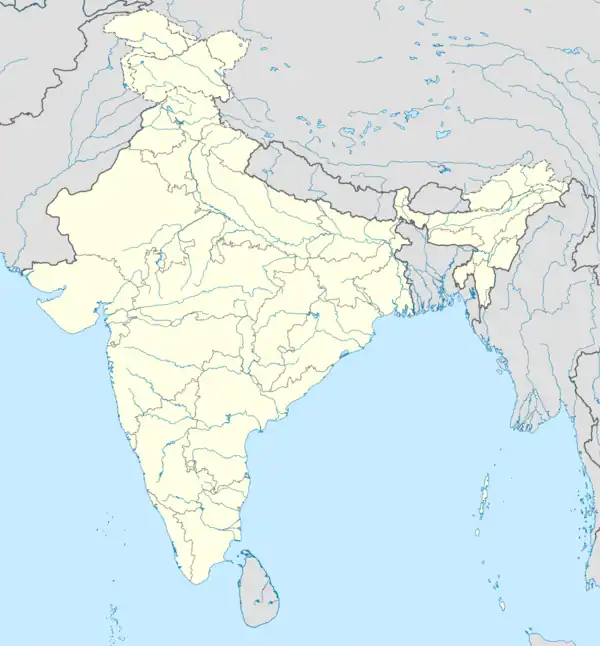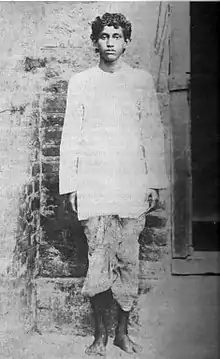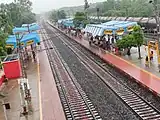Tamluk
Tamralipta, Tamolika, Tamralipti, Tamoluk | |
|---|---|
City | |
 Bargabhima temple at Tamluk | |
 Tamluk Location in West Bengal, India  Tamluk Tamluk (India)  Tamluk Tamluk (Asia) | |
| Coordinates: 22°18′N 87°55′E / 22.3°N 87.92°E | |
| Country | |
| State | |
| District | Purba Medinipur |
| Government | |
| • Type | Municipality |
| • Body |
|
| Area | |
| • Total | 17.86 km2 (6.90 sq mi) |
| Elevation | 7 m (23 ft) |
| Population (2011)[2] | |
| • Total | 65,306 |
| • Density | 3,700/km2 (9,500/sq mi) |
| Languages | |
| • Official | Bengali[3][4] |
| • Additional official | English[3] |
| Time zone | UTC+5:30 (IST) |
| PIN | 721636 721627 721648 721649 |
| Telephone code | 91-3228 |
| Vehicle registration | WB 29-xxxx, WB 30-xxxx |
| Lok Sabha constituency | Tamluk |
| Vidhan Sabha constituency | Tamluk |
| Website | purbamedinipur |


Tamluk (/ˈtæmlʊk/) is a town and a municipality in the Indian state of West Bengal. It is the headquarters of the Purba Medinipur district. Though there is some controversy, scholars have generally agreed that present-day Tamluk is the site of the ancient city variously known as Tamralipta or Tamralipti, where Hien Chang, a Chinese traveller, visited the town, is now located on the banks of Rupnarayan River, close to the Bay of Bengal.
Name
According to T. N. Ramachandran, the name "Tamluk" is related to the older form Tamālikā, which is a variant spelling (found in the Trikāṇḍaśesha) of the ancient name Tāmraliptī (or Tāmralipta). Other names listed in the Trikāṇḍaśesha and the Abhidānachintāmaṇi as referring to Tāmraliptī include Staṁbhapura, Velākūla, and Vishṇugṛiha.[5]: 229
History
This ancient kingdom and port city was bounded by the Bay of Bengal in the south, Rupnarayan River in the east and Subarnarekha River in the west. The Rupnarayana is the joint flow of the rivers Dwarakeswar and Silai. The Bay of Bengal and these great rivers with their numerous branches created a prosperous and easy water navigational system fostering commerce, culture and early contacts with the people outside the region. At the same time, these rivers helped to develop the agriculture in this region.[6]
Archaeological remains show continuous settlement from about the 3rd century BC. It was known as Tramralipta (in the Puranas and the Mahabharata), Tamralipta (in the Mahabharata), Tamalika (in historical documents), Tamalitti (in foreigners' descriptions), or Tamoluk (in the British Raj). It was a seaport, now buried under river silt. For this reason, Tamluk has many ponds and lakes remaining today.[7][8][9]
In the Mahabharata (Bhishma Parba/Nabam Adhyay), while describing the names of the holiest rivers and kingdoms of India, Sanjay took the name of "Tramralipta" to Dhritarashtra.[10][11][6]
Tamluk was also known as Bhivas, in religious texts, and Madhya Desh, as the Middle State of Utkal/Kalinga and Banga.
According to Jain sources, Tamralipti was the capital of the tamralipti janapada and was long known as a port.[12][13][5][14]
Archaeology
Several archaeological find sites have been found in Tamluk, including a number of high mounds in the town as well as in and around various tanks. The Bargabhīmā Temple, in the middle of town, is built on one such mound. Another mound is now occupied by the local Mission house. Here, people digging a well found wood fragments at a depth of 50 feet, which T. N. Ramachandran compared to the remains of the Maurya-era wooden palisade found at Pataliputra. At another high mound, this one by the Rupnarayan riverbank, a hoard of about 350 coins dated to the 1st-2nd centuries BCE was found by K. N. Dikshit in the early 1920s.[5]: 230–2
Just east of the Rajbari in central Tamluk is a large square tank called Khātpukūr, which probably dates from the 15th century. Digging here, Ramachandran's group found terracotta remains with similarities to Shunga-period artifacts, but because of where they were found, Ramachandran did not assign them a date. Among the artifacts found at Khātpukūr were a couple of Egyptian-style vases, which also could not be dated. They may have been either imports from Egypt or local imitations of Egyptian style. Either way, their presence indicates long-distance cultural contact due to maritime trade, as would be expected at a major port like Tāmraliptī. At another site, "an oblong tank next to the local school", old brick walls and terracotta fragments were found under Gurusday Dutt. Various items were found in and around a couple of tanks on Adhikaripara Road, Padambasan Road, and School Road.[5]: 230, 235–7
A group led by T. N. Ramachandran undertook a survey of various sites in Tamluk in the 1940s.[5]: 229–30
Geography
M: municipal city/ town, CT: census town, R: rural/ urban centre, H: historical/ religious centre
Owing to space constraints in the small map, the actual locations in a larger map may vary slightly
Tamluk is located on the right bank of the Rupnarayan river, about 19 km upstream from where it joins the Hooghly River.[5]: 226
Police station

Tamluk police station has jurisdiction over Tamluk (municipality) and Tamluk CD Block. Tamluk police station covers an area of 214.14 km2 with a population of 352,748.[15][16]
Demographics
According to 2011 Indian Census, Tamluk had a total population of 65,306, of which 33,260 were males and 32,046 were females. Population within the age group of 0 to 6 years was 6,180. The total number of literates in Tamluk was 53,318, which constituted 81.6% of the population with male literacy of 85.0% and female literacy of 78.1%. The effective literacy rate of population (7 years and above) of Tamluk was 90.2%, of which male literacy rate was 94.0% and female literacy rate was 86.2%. The Scheduled Castes and Scheduled Tribes population was 4,441 and 201 respectively. Tamluk had 14489 households in 2011.[2]
Transport
Tamluk has two railway stations - Tamluk Junction and Sahid Matangini.
Education
Schools
- Sudhir Memorial Institute Tamluk :- It is an CBSE English - Medium School in Tamluk. It is a Sister Institute of Sudhir Memorial Institute Madhyamgram.
- Matangini Mission School, Tamluk :- It is a Bengali & English - Medium School in Tamluk.
- Tamluk Hamilton High School :- A school under West Bengal board (WBBSE, WBCHSE, and WBSCTE), established on 1852.
- Rajkumari Santanamoyee Girls' High School :- A school under West Bengal board (WBBSE and WBCHSE).
- Tamluk High School :- A school under West Bengal board (WBBSE and WBCHSE).
- Demari High School :- A school under West Bengal board (WBBSE and WBCHSE).
- Tamralipta Vidyapith School : A school under West Bengal board (WBBSE and WBCHSE).
- Ratnali Adarsha Valika Vidyalaya : A school under West Bengal board (WBBSE and WBCHSE).
- Radhaballavpur Bhima Charan Basu Vidyapith : A school under West Bengal board (WBBSE and WBCHSE).
- Kulberia Bhimdeb Adarsha Vidyapith :A school under West Bengal board (WBBSE and WBCHSE).
- Bhander Beria Debendra High School : A school under West Bengal board (WBBSE and WBCHSE).
- Kakgechia Satyanarayan High School : A school under West Bengal board (WBBSE and WBCHSE).
- Jogikhop Girl High School : A school under West Bengal board (WBBSE and WBCHSE).
- Banhichar High School : A school under West Bengal board (WBBSE and WBCHSE).
- Kelomal Santoshini High School : A school under West Bengal board (WBBSE and WBCHSE).
- Nakibasan High School : A school under West Bengal board (WBBSE)
- Tamralipta Public School, an ICSE affiliated school upto standard 12th
- Daharpur Tapashili High School (WBBSE and WBCHSE)
- Salgechia High School (WBBSE and WBCHSE)
Colleges
- Tamralipta Mahavidyalaya was established in 1948. It is affiliated to Vidyasagar University. It offers courses in arts, science, commerce and education.[17]
- Shahid Matangini Hazra Government College for Women was established at Nimtouri, Tamluk in 2015. It is affiliated to Vidyasagar University.
- Tamralipto Government Medical College and Hospital, established in 2022. It is affiliated to West Bengal University of Health Sciences
Business
Nursing Home
The Town has recently seen an increase in the number of private Nursing Homes, serving people of the town and mostly of the rural areas in and around Tamluk.
Tamluk also is a growing medical Hub, with chambers of many reputated doctors, that have brought top level diagnosis and facilities to the people of Tamluk and rural villages beside Tamluk.
Some of the most advanced Nursing Homes in Tamluk are
- Mas Clinic and Hospital
- APJ Abdul Kalam Super speciality Hospital
- TUI - Tamluk Urology Institute
- Balaji Nursing Home
- Paradise Nursing Home
Diagnostic Centres
Along with Nursing homes, top notch diagnostic centres have also developed in the Town, that brings in advance level diagnosis to the rural people.
Landmarks and tourist places

- Rupnarayan river bank: The bank of river Rupnarayan is famous for picnic.
- Devi Barghobhima: Nearly 1150-year-old Temple of Kali named as Devi Bargobhima. This temple is a part of 51 Shakti Peethas. Puranas say that the small finger of left feet of Sati/Parvati fell here when Lord Vishnu cut the sacred Body of Goddess Sati into several pieces to pacify Lord Shiva.
- Tamluk Rajbari: Located on the outskirts of town, the old ruined royal abode of the Bhanj dynasty (Mayur/Peacock),[18] is a tourist destination.
- Rakhit Bati: It is another place to visit in Tamluk. In the beginning of 19th century it was a secret centre of the then revolutionary party Anusilan Samiti & Gupta samiti. The historian late Shri Tailakyanath Rakhit rebuilt this building.
- Geonkhali: At geonkhali river Rupnarayan joins Hooghly river.
Notable people
- Khudiram Bose, young revolutionary and martyr
- Matangini Hazra, Indian independence movement revolutionary and martyr
- Satish Chandra Samanta, Indian independence movement activist and leader of Tamralipta Jatiya Sarkar
- Ajoy Mukherjee, former chief minister of West Bengal.
- Sushil Kumar Dhara, Co founder of Tamralipta Jatiya Sarkar of British India & after independence he also served the state government as `Industry and Commerce Minister'.
- Paresh Maity, artist.
- Mani Lal Bhaumik,[19] Indian American physicist and best-selling author
Gallery
 Khudiram Bose
Khudiram Bose Tamluk Junction railway station
Tamluk Junction railway station Tamluk Junction Foot-over Bridge
Tamluk Junction Foot-over Bridge Alpona at Tamluk Junction Foot-over Bridge
Alpona at Tamluk Junction Foot-over Bridge A view from foot over bridge
A view from foot over bridge Rupnarayan river bank, Tamluk
Rupnarayan river bank, Tamluk
See also
References
- ↑ "Tamluk Info". sudawb.org. Retrieved 25 November 2020.
- 1 2 "Census of India: Tamluk". www.censusindia.gov.in. Retrieved 9 October 2019.
- 1 2 "Fact and Figures". www.wb.gov.in. Retrieved 15 January 2019.
- ↑ "52nd Report of the Commissioner for Linguistic Minorities in India" (PDF). nclm.nic.in. Ministry of Minority Affairs. p. 85. Archived from the original (PDF) on 25 May 2017. Retrieved 2 March 2019.
- 1 2 3 4 5 6 Ramachandran, T. N. (1951). "Tāmraliptī (Taṁluk)". Artibus Asiae. 14 (3): 226–239. doi:10.2307/3248590. ISSN 0004-3648. JSTOR 3248590.
- 1 2 Dilip K. Chakrabarti (2001). Archaeological Geography of the Ganga Plain: The Lower and the Middle Ganga. Orient Blackswan. p. 125. ISBN 978-81-7824-016-9.
- ↑ Schendel, Willem van (12 February 2009). A History of Bangladesh. Cambridge University Press. p. 16. ISBN 978-1-316-26497-3.
- ↑ Tripati, S.; Rao, S. (1 January 1994). "Tamralipti: The Ancient Port of India". Studies in History and Culture. 2: 33–39.
- ↑ "History | Purba Medinipur | India". Retrieved 18 March 2022.
- ↑ Puri, Baij Nath (1966). Cities of Ancient India. Meenakshi Prakashan. p. 110.
- ↑ Choudhury, Pratap Chandra (1988). Assam-Bengal Relations from the Earliest Times to the Twelfth Century A.D. Spectrum Publications. p. 67.
- ↑ Schmiedchen, Annette (2019). "Medieval Endowment Cultures in Western India: Buddhist and Muslim Encounters – Some Preliminary Observations". Mondes de l'Asie du Sud et de l'Asie Centrale: 7.
- ↑ Paine, Lincoln (6 February 2014). The Sea and Civilization: A Maritime History of the World. Atlantic Books. p. 265. ISBN 978-1-78239-357-3.
- ↑ Bhaumick, Manoranjan (2001). History, Culture, and Antiquities of Tāmralipta. Punthi Pustak. pp. 7–8. ISBN 978-81-86791-27-1.
- ↑ "District Statistical Handbook 2014 Purba Medinipur". Tables 2.1, 2.2. Department of Statistics and Programme Implementation, Government of West Bengal. Archived from the original on 29 July 2017. Retrieved 10 November 2016.
- ↑ "Tamluk PS". Purba Medinipur District Police. Retrieved 10 November 2016.
- ↑ "Tamralipta Mahaviyalaya". TM. Retrieved 1 April 2017.
- ↑ Shashwati Pandit (2 February 2021), Bargabhima temple: seeking an unknown mystery (PDF), IIJCRT
- ↑ ".:: Dr. Mani Lal Bhaumik ::". www.midnapore.in. Retrieved 16 July 2021.

